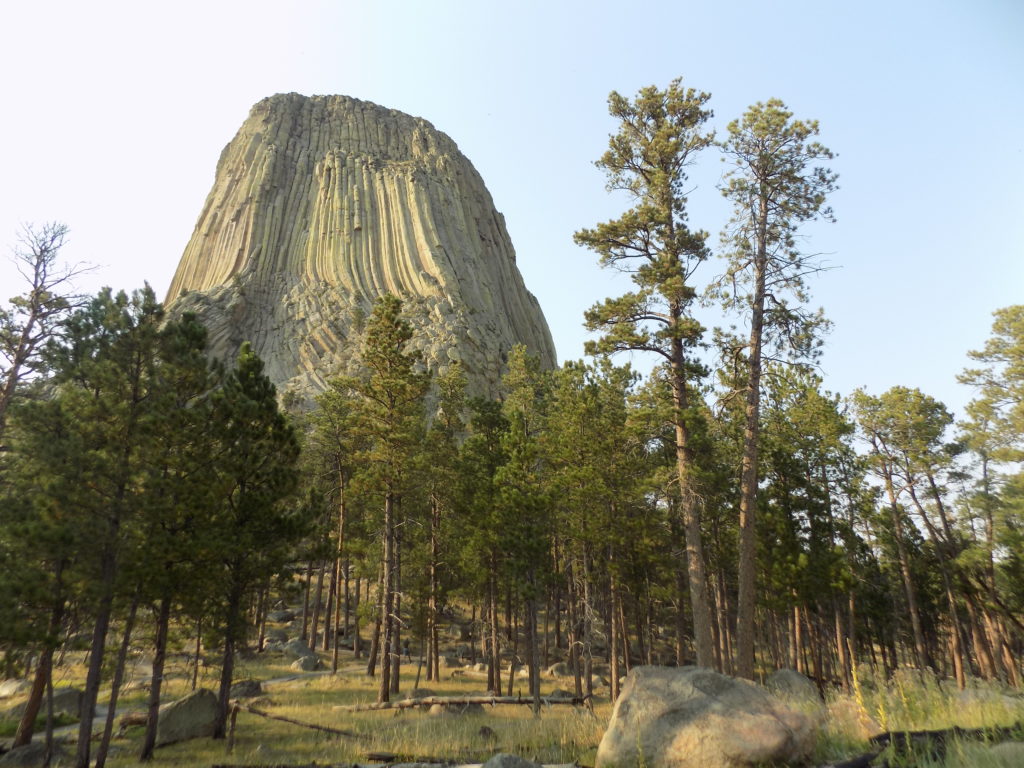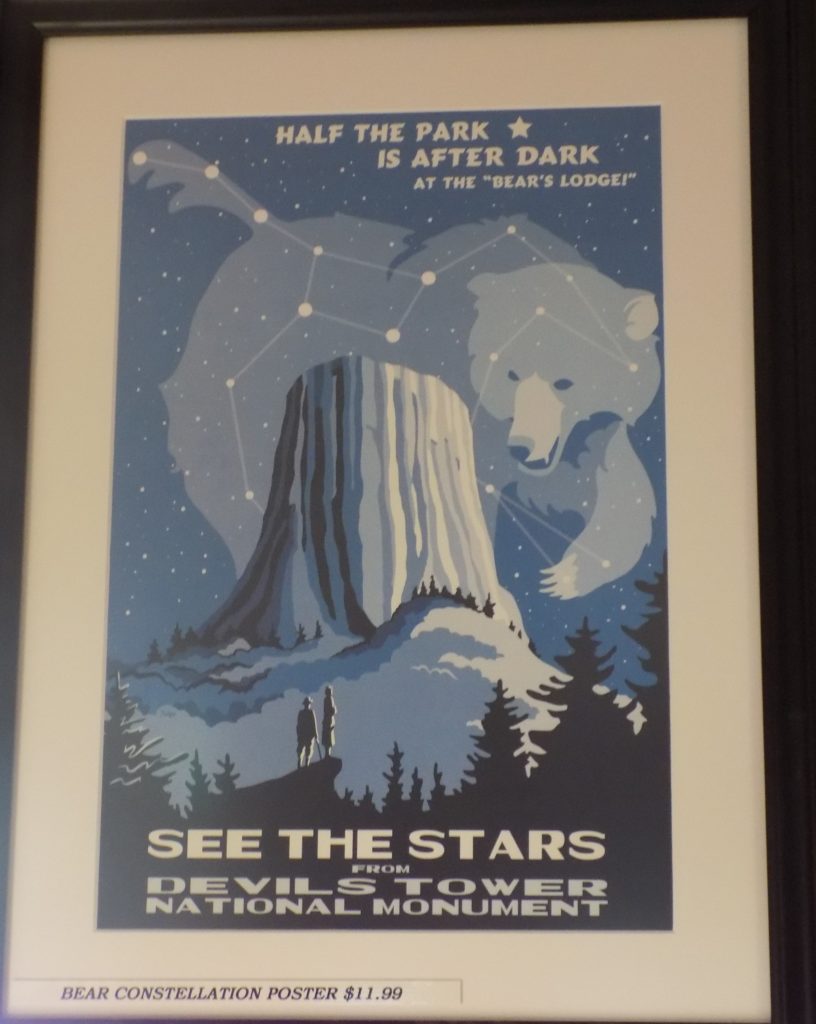As I’ve written in other pages on this site, while I engage in research before I leave to visit a place then typically supplement it with more reading after my return, the goal of that research is to enrich my understanding (and I hope yours) of those places. I will never claim (and you should never conclude) that my research is thorough or has great depth. With that caveat, I will say that the combination of information provided at the Devils Tower Visitor’s Center and Frank’s assertions prompted some additional albeit superficial research (mainly from this website) about Plains Native American beliefs in the afterlife. Here’s some of what I learned:
The Cheyenne believe that the souls of the dead travel along the Milky Way:
Father Peter J. Powell, in his book Sweet Medicine: The Continuing Role of the Sacred Arrows, the Sun Dance, and the Sacred Buffalo Hat in Northern Cheyenne History, reports: “For the Cheyennes, there is no hell or punishment after life on earth.” In his book The Cheyenne Indians: Their History and Lifeways, George Bird Grinnell writes: “The spirit of the dead man found the trail where the footprints all pointed the same way, followed that to the Milky Way, and finally arrived at the camp in the stars, where he met his friends and relatives and lived in the camp of the dead.”
Similarly, in The Omaha Tribe
ethnographers Alice Fletcher and Francis La Flesche report: “There does not seem to have been any conception among the Omaha of supernatural rewards or punishments after death.”
And finally,
Concerning beliefs regarding an afterlife among Plains Indians, Charles Eastman, in Light on the Indian World: The Essential Writings of Charles Eastman (Ohiyesa), writes: “The idea of a ‘happy hunting-ground’’is modern and probably borrowed, or invented by the white man.”
These sources certainly belie Frank’s assertions. As for his claim of Dodge’s linguistic fluency, once source on the name notes that in Lakota the word for bad god or evil spirit is wakansica, and the word for black bear is wahanksica. It seems possible and plausible that Dodge simply misheard or mistranslated the word.
Here’s what you can learn from a stop in the Visitor’s Center at Devils Tower if you read the placards. You will see this on one of them:
You’ll also see this poster for sale:
The Indian Law resource center notes that Bear Lodge is a sacred site for more than 20 different Native American tribes and that for “centuries, Indians have performed religious and cultural ceremonies there, including the Sun Dance, sweat lodge rites, vision quests, and prayer offerings.” For me, the weight of the evidence lends itself to the idea that Dodge was wrong.
Later this week, I’ll visit Yellowstone National Park which was established in 1872 as the world’s first national park. By the time President Theodore Roosevelt signed the Antiquities Act on 8 June 1906, the U.S. had five additional National Parks (Sequoia, Yosemite, Mt. Rainier, Crater Lake, and Wind Cave) but no National Monuments. Roosevelt changed that on 24 September 1906 when, under the Act, he declared Devils Tower as the first official National Monument in the United States.
You might have noticed that in my writing and on the photos above, the name is inscribed as Devils Tower rather than Devil’s Tower. Somehow, in the process of transcribing Roosevelt’s declaration someone made a clerical error and omitted the apostrophe. It was never corrected.
Hiking around the Tower
For those of you awaiting the geological history of the tower, fear not, I shall include it. I simply thought that since you’d plodded through all the history surrounding the Battle at Little Bighorn I’d treat you to some actual travel before diving into the science – such as it is.
For those not inclined to attempt to climb the Tower (this is a limited opportunity regardless of your level of interest), there are three trails to hike. Although my ankle had improved from the incident the first night, it was still a bit tender so, for that reason, coupled with having limited time before I needed to return to Frank’s B & B, I chose the shortest (1.3 miles) and most popular of the three – the Tower Trail which affords close up views of the Tower as you walk through the boulder field and ponderosa pine forest at its base.
One aspect of the walk I found fascinating was not simply the way in which the Tower varied in appearance as I circumnavigated it
 but also how the sounds of wildlife and even the wind changed depending on my position relative to it. When I met Frank, he told me that some of the sounds I heard – a sort of high-pitched zhee-zhee-zhee-zhee – were most likely swifts which are one of more than 160 species of bird found in the monument’s environs. He then pointed to two or three turkey vultures enjoying themselves as they soared on the circulating air currents the Tower creates. I’m still not sure how but I managed to catch one in the lens of my camera.
but also how the sounds of wildlife and even the wind changed depending on my position relative to it. When I met Frank, he told me that some of the sounds I heard – a sort of high-pitched zhee-zhee-zhee-zhee – were most likely swifts which are one of more than 160 species of bird found in the monument’s environs. He then pointed to two or three turkey vultures enjoying themselves as they soared on the circulating air currents the Tower creates. I’m still not sure how but I managed to catch one in the lens of my camera.
 I told Frank I was looking forward to dinner and meeting his other guests and we parted ways – heading in opposite directions. Continuing at a leisurely pace, I finished my circuit and stopped in the Visitor’s Center where I overheard someone asking the ranger about climbing the Tower and commented that I was staying with someone who must have a permanent pass. The ranger immediately said, “You must be staying with Frank Sanders.” I asked how she knew and she answered with a spryness in her voice that left me uncertain whether it hinted at amusement or trouble that all the rangers knew Frank.
I told Frank I was looking forward to dinner and meeting his other guests and we parted ways – heading in opposite directions. Continuing at a leisurely pace, I finished my circuit and stopped in the Visitor’s Center where I overheard someone asking the ranger about climbing the Tower and commented that I was staying with someone who must have a permanent pass. The ranger immediately said, “You must be staying with Frank Sanders.” I asked how she knew and she answered with a spryness in her voice that left me uncertain whether it hinted at amusement or trouble that all the rangers knew Frank.
When I returned to the lodge I had enough time to wash up, and upload my photos before I came out to the dinner table.
I’ll take a more scientific look at the Tower in Part 3.



